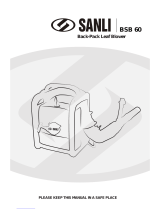
BG 56, BG 56 C, BG 66, BG 66 C, BG 86, BG 86 C, SH 56, SH 56 C, SH 86, SH 86 C
English
5
To reduce the risk of damage to
property, also maintain this distance
from other objects (vehicles, windows).
When blow-sweeping and vacuum
shredding (in open ground and
gardens), watch out for small animals to
avoid harming them.
Never leave a running machine
unattended.
Take special care in slippery conditions,
on slopes or uneven ground.
Watch out for obstacles: Be careful of
refuse, tree stumps, roots and ditches
which could cause you to trip or stumble.
Never work on a ladder or any other
insecure support.
Be particularly alert and cautious when
wearing hearing protection because
your ability to hear warnings (shouts,
alarms, etc.) is restricted.
Work calmly and carefully – in daylight
conditions and only when visibility is
good. Stay alert so as not to endanger
others.
To reduce the risk of accidents, take a
break in good time to avoid tiredness or
exhaustion.
Mufflers with a catalytic converter can
become particularly hot.
To reduce the risk of serious or fatal
injury from breathing toxic fumes,
ensure proper ventilation when working
in trenches, hollows or other confined
locations.
To reduce the risk of accidents, stop
work immediately in the event of
nausea, headache, visual disturbances
(e.g. reduced field of vision), problems
with hearing, dizziness, deterioration in
ability to concentrate. Apart from other
possibilities, these symptoms may be
caused by an excessively high
concentration of exhaust gases in the
work area.
To reduce the risk of fire, do not smoke
while operating or standing near your
power tool. Note that combustible fuel
vapor may escape from the fuel system.
If dust levels are very high, always wear
a suitable respirator.
Operate your power tool so that it
produces a minimum of noise and
emissions – do not run the engine
unnecessarily, accelerate the engine
only when working.
After finishing work, put the unit down on
a level, non-flammable surface. To
reduce the risk of fire, do not put it down
near easily combustible materials (e.g.
wood chips, bark, dry grass, fuel).
Never attempt to insert objects into the
blower housing through the intake
screen or the nozzle. They may be
expelled at very high speed by the
blower – risk of injury.
If there is a noticeable change in running
behavior (e.g. higher vibrations), stop
work and rectify the cause of the
problem.
If your power tool is subjected to
unusually high loads for which it was not
designed (e.g. heavy impact or a fall),
always check that it is in good condition
before continuing work – see also
"Before Starting Work". Check the fuel
system in particular for leaks and make
sure the safety devices are working
properly. Do not continue operating your
power tool if it is damaged. In case of
doubt, consult your servicing dealer.
To reduce the risk
of injury from
thrown objects, do
not allow any other
persons within a
radius of 5 meters
of your own
position.
Do not direct the air blast
towards bystanders or
animals since the air flow
can blow small objects at
great speed – risk of
injury.
Your power tool produces
toxic exhaust fumes as
soon as the engine is
running. These fumes
may be colorless and
odorless and contain
unburned hydrocarbons
and benzol. Never run
the engine indoors or in
poorly ventilated loca-
tions, even if your model
is equipped with a cata-
lytic converter.




















